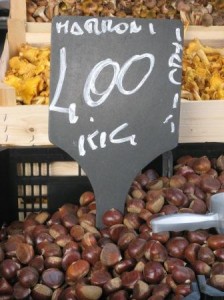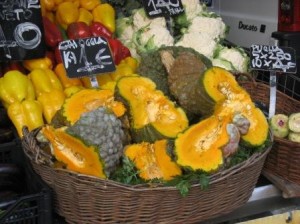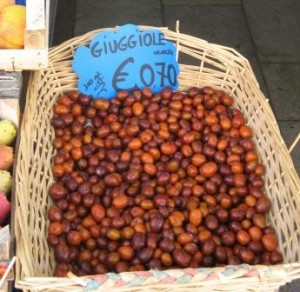By which I don’t mean the financial market, and “today” is generally intended to mean more-or-less now. I’m referring to what new edibles are on sale in the market these days.
As I may have mentioned elsewhere, one of the many ways in which I notice the seasons changing is by what arrives and departs from the fruit and vegetable stands. (Fish also. Meat pretty much stays the same.)
I should note that in the past few years the rot of nonlocal-feedlot-hothouse-raised-out-of-season comestibles has begun to set in. I used to love the fact that you really could stick with the seasonal offerings here — in fact, you hardly had a choice.
Now there are strawberries in January and cherries in September and artichokes virtually all the time. It’s grotesque, and not only because of the prices. That there is a market for them is what’s distressing. Happily, a few items such as fresh peas and cardoons and loquats and parsnips have eluded the commercial drift-net so far, that mechanism that sweeps products indiscriminately off the calendar and dumps them all onto the shelves and into the bins together.

So what makes my heart leap up when I see plants take their cues and slip onto the autumnal culinary stage here? Walnuts — Italian, as well as from California.

Chestnuts from various parts of northern Italy, the most prized being from Piedmont, around the town of Cuneo. “Zucca barucca,” a pumpkin which if you didn’t know it was so good you’d think was a sort of mutated Hobbit. Cachi (KA-kee), or persimmons. The leafless branches of trees in gardens here are festooned with these golden spheres far into the fall, little grace-notes of sun in a season which becomes progressively grayer. If I were a canning-and-preserving person, I’d be working around the clock.


Best of all, the giuggiole (JOO-joe-leh). It’s better in Venetian: zizoe (ZEE-zo-eh). In English: jujubes. You may think of jujubes only as that gummy candy you’d buy at the movies when you went for the Saturday-morning double feature. But they are a real fruit, perhaps a bit handicapped by the fact that they look like olives wishing they could be dates.

Modest though they may be, they have their own place in Italian culture. For example, there is an expression — “andare in brodo di giuggiole” (literally, “I went into jujube broth”) — which you would say when you wanted to convey extreme happiness or satisfaction. The “broth” is a sort of infusion/decoction which evidently is more delectable than you can imagine. Only now have I discovered a recipe for this beverage, or I’d have tried to make it before the zizoe disappeared and given a full report.
Around here the zizoe come mainly from the area of the Euganean Hills, beyond Padova, especially the environs of the hamlet of Arqua’ Petrarca, where Petrarch settled to live out his last days. The Arquites (or whatever the inhabitants are called — Arquatensi, actually) dedicate not one, but two Sundays in October to celebrating their yummy little drupe.
The Romans brought them from Syria; Herodotus noted that the wine you could make from jujubes would get you drunk in no time. (I’m freely translating.) There are recipes from the Egyptians and even Phoenicians.
Apart from its alcoholic potential, and the fact that it has more Vitamin C than the orange, it was especially valued by our forebears as being one of a group of so-called “chesty” fruits (such as figs, dates and grapes) which produced a liquid which, when condensed, could combat chest colds and respiratory inflammation, of which there is no shortage in this climate.
Here’s a recipe, which I’m already poised to try. All I have to do is wait till the end of next September.
BRODO DI GIUGGIOLE
- 1 kilo (2.2 pounds) jujubes
- 1 kilo sugar
- two bunches of Zibibbo or Muscat grapes
- 2 glasses (no size specified…) of white wine
- 2 quinces
- grated lemon peel
- sufficient water
- Wash the jujubes and put them in a pot. Cover with water.
- Add the grapes and the sugar.
- Simmer over low flame for 1 hour, stirring frequently with a wooden spoon.
- Peel and thinly slice the quinces.
- Add sliced quinces and wine to the pot.
- Raise the flame to more rapidly evaporate the alcohol. Turn off heat. Cool.
- When it is cooler, stir in the grated lemon peel.
- Pass the mixture through a sieve, pour the liquid into jars and completely cool.
- Leave in a cool place for at least a month before using.
I’ll see you next year with this one. It will be the Great Zizoe Broth-off.

1 Comment
Yummy photos 🙂
Funny that those jujubes are soooo totally unknown here in Austria. It’s not that far from Italy, after all.
I know them from China, where they are eaten but also serve as an important ingredient in Chinese medicine.
Actually, the Italian wikipedia article says that in Italy they are also called “dattero cineseâ€.
(By the way, they have also an interesting list of the word for giuggiole in many various Italian dialects. I love this kind of information.)
Your recipe sounds very delicious!